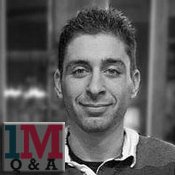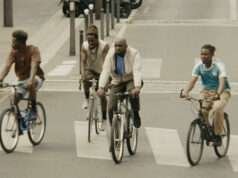Paul Booth chats to Filmmaker Jeremy Weiss…
This week we have Jeremy Weiss from New Jersey bringing some Jazz into the mix of his filmmaking. Take note, Jeremy discusses Sonny Rollins (Saxophonist), if you want your life changed forever then grab some Rollins. Lets get rolling with some East Coast flavor on this Filmmaker Friday.
Paul Booth: Where are you from? How long have you been making films?
Jeremy Weiss: I am originally from Summit, New Jersey, which is located a few miles outside of New York City–where I was born. I moved around a lot before I turned eight—even spent two years overseas in Basil, Switzerland, but some how I always ended up back in Summit.
I have been making films since I was a freshman in college, although my mother will insist that I have been making films my whole life. I used to film re-enactments of movies, like Star Wars and Wayne’s World, with friends when I was a kid. I had no idea what I was doing at the time. The process was filled with trial and error that was inspired from observation. I had no editing equipment so I would cut each film in the camera. It was a lot of fun, but I didn’t start taking filmmaking seriously until I entered college.
PB: Did you go to film school?
JW: I did attend film school, although I did not originally attend school for film. Before attending college I had taken three years of photography in high school but I had never given motion pictures any serious consideration. I originally went to St. Andrews Presbyterian College in North Carolina for sports management, but a single course changed my life forever.
During my first semester I met Professor Richard Brett who taught a course that ignited my passion for filmmaking called Broadcast Mediums. Before the end of that year I was in production filming my first short film, “Future Today, Gone Tomorrow,” a Twilight Zone-inspired tale about a man who has premonitions of the September 11th terrorist attacks. Brett became my mentor and pushed me ahead to all his advanced classes. He even chose me to go to Italy to be the Director of Photography on his feature-length film Privat. He continues to be a big influence on my work today.
Later, I attended Emerson College in Boston, Massachusetts. Going to Emerson prepared me for life in Los Angeles better than I could have ever imagined. The professors there helped me develop thick skin and taught me how to express my artistic voice. They helped me explore the themes that make my work quintessentially my own, and helped me mature as a filmmaker.
I was very frustrated my first year in Boston because I did not understand my professors’ point of views or what they were asking from me. Since I didn’t comprehend, I tried to mimic the success what was expected of me, and in doing so I began to lose myself. My Emerson experience began bearing fruit during my second of three years there, after my professors encouraged me to make a film solely for my own benefit. I made a film called, “The Eyes of Others, The Weiss Manifesto.” It was an experimental short where I projected digital images of what other people had told me was the “perfect person” to be in life. Despite the fact that the film’s message and theme geared only towards myself, I was amazed at how well it was received. This was the greatest lesson and experience Emerson College gave to me. My professors taught me how to add deeper meaning to my work and speak with an artistic voice that was unique and passionate.
PB: What made you want to make a Jazz Film?
JW: I wanted to make a jazz film because jazz has always had a special place in my heart. When I was in high school my friends were in the jazz band and always talking jazz. I didn’t play an instrument like they did, but I enjoyed listening to them jam. Another big moment that grew my appreciation for jazz happened when I was a freshman in college. My mother made a donation to WBGO 88.3 FM, a very popular jazz radio station in Newark, NJ, that allowed me to be a guest DJ on their morning show with Gary Walker. I was allowed to choose the playlist for the hour I was on air, and that give me an opportunity to be introduced to a whole new group of jazz musicians. My friend Tom shared his jazz albums with me and together we built a playlist starring names like Dexter Gordon, Duke Ellington, Charlie Parker and Sonny Rollins. After that experience I was hooked. I started listening to jazz and going to jazz clubs around New York and New Jersey on a regular basis. That environment inspired me to make Riff Raf. I wanted to make a jazz film because I wanted to share the music that I love so much with a whole new generation of people who might not know it’s out there. Jazz has always had a way of touching my soul whether listening to a jazz quartet in a club or hearing the notes of a busting saxophone echoing over busy city streets. It is raw and it is real!
PB: Who are you favorite filmmakers?
JW: I have a wide range of filmmakers and entertainers who I consider my favorites because each does something unique that speaks to me as a creator. My list of favorite directors, in no particular order, includes Martin Scorsese, Alfred Hitchcock, Woody Allen, Michael Curtiz, Gus Van Sant, Peter Weir, and George Roy Hill. However, the directors who I closest relate to in theme are Harold Ramis, Shawn Levy and Steven Spielberg because simply each one has a very positive outlook and understanding on life.
PB: What made you want to shoot it in black and white?
JW: There are many reasons why I wanted to shootRiff Raf in black and white. I think black and white is a beautiful medium that still has a place in modern-day filmmaking—besides flashbacks and period pieces that it is most commonly used for today. Shooting in black and white helped C.E Courtney (Director of Photography) and I create a fairy tale and classic like look for Riff Raf that shooting in color wouldn’t have been able to do. It helps keep audiences engaged in the story and less likely to be questioned the events by establishing a reality that isn’t perfectly identical to that of everyday life.One of the biggest influences on the look of Riff Rafin black and white was Good Night and Good Luckfrom 2005. It is one of my favorite films.
*****
PB: What Jazz players influenced your script and process?
JW: Probably the biggest influence on Riff Raf as far as jazz goes was Sonny Rollins. Sonny Rollins is my favorite saxophonist, and in earlier versions of the story, Raf, the protagonist, was a sax player too. However, when I committed to the classical orchestra the story had to change because the sax is not a traditional classical orchestra instrument. So Raf became a jazz trumpeter instead. After that, I met Nick Grondin who became the film’s jazz arranger, and Daniel Henderson, trumpet player. They became the biggest influences as they added their own personal and unique touch to Raf’s musical sound.
PB: How long was the creative process of Rif Raff?
JW: Riff Raf took only four days to shoot. However, development and preproduction are another story. That was about an eleven-month process where I found myself, on more than one occasion, staring down the barrel of not graduating Emerson College on time. When I set out to make Riff Raf I wanted to challenge myself to acquire resources that weren’t easily at my disposal. I knew I was coming to Los Angeles and I wanted Riff Raf to be an exercise in Hollywood filmmaking. I tested myself and built the film from nothing while selling it only on my passion. It was very important to have veteran musicians in the orchestra whose experience could be visually seen. Despite the difficulties of acquiring an orchestra I wouldn’t compromise on it because I believed it added significant tension of Raf being in the wrong place at the wrong time. Some people suggested that I use a student orchestra in order to make the process easier. However, I felt having a 28-year-old jazz musician mixed into a student recital would have been kind of silly and visually less dramatic due to the weight of the situation.
After the first draft of the screenplay was completed, I started an incredible letter writing campaign addressed to every musical director and conductor in the greater Boston area. The results were a lot of rejections and no replies. I considered each new contact a success if that person was able to open a door to more contacts. In December of 2011, I passionately pitched the story ofRiff Raf to Matthew Fritz, the music director of the Parkway Concert Orchestra in Norwood Massachusetts, and told him how his creative collaboration would help the film succeed. Matthew must have liked what he heard, because he agreed to join the project almost immediately. It was the first big victory of the film and shortly after the rest of the pieces started falling into place. Matthew contracted out the veteran musicians I was seeking to record and film our concert piece, I was introduced to Nick Grondin a local jazz musician in January of 2012 and he agreed to lead the jazz ensemble, and C.E. Courtney, a veteran of Hollywood signed on as the projects Director of Photography.
I was writing and rewriting the story up until the day we finally started shooting. I finished the treatment in May of 2011 and the first draft later in June, but the screenplay went through numerous changes before I settled on a story that I liked. Originally, the film was set in Italy. Raf was an American jazz musician backpacking through Europe. I wanted to challenge myself as a director to tell the story solely with visuals. I wanted to lead viewers without subtitles through context clues and subtext because I have always felt that the most rewarding viewing experiences come from stories that make me work to understand what’s going on. Unfortunately, there were too many challenges in making Boston appear like an Italian city. Throughout the writing process I continued to get Riff Raf in front of every new pair of eyes I could. I constantly wanted new perspectives on how the story was being preserved. I was never afraid of harsh criticism. In fact I welcomed it. I wanted there to be no confusion in the message I was trying to communicate and honest and critical feedback helped me achieve that.
PB: What is the message you want audiences to take from Riff Raf?
JW: The theme of Riff Raf is finding common ground with others and not allowing stress to stand in your way of enjoying life—as it does for Cesare, the clarinet player who only wants to have fun with his music and almost lets a golden opportunity to do so slip away due to his pride. Also that music is the universal language and can bring people together from all walks of life. But mostly I made Riff Raf with the hope that audiences will be entertained by it. The world can be a pretty stress-filled place, and if people come away from viewing the film with a smile and the weight of their life lifted off their shoulders, even for just a moment, then I consider that a success.
PB: What was one major thing you learned from making Riff Raf?
JW: The biggest lesson that I learned from Riff Raf is that today’s no is tomorrow’s yes. Throughout the process of making Riff Raf I was told that the film couldn’t be made, and the lack of progress early in the film’s development backed that claim up. I was told that it would be too difficult to produce, that it was too ambitious for a student project, and that I should do something less challenging. For the first eight months of pre-production it felt like all I heard was no, and that it can’t be done. However, I kept a positive attitude. I knew in my heart there was no other project for me to make. I believed in the story and I swore to myself by hook or by crook I was going to make it happen.
The lessons I learned during Riff Raf helped prepare me for life in Los Angeles. This is a city and a profession built around telling people no. It would be much easier to give up and do something else. However once again I find myself staying positive against great adversity. There has never been another profession that I have ever felt so passionate about, and by hook or by crook one day I am going to make it work.
Interview by Paul Booth
Visit us on Facebook







